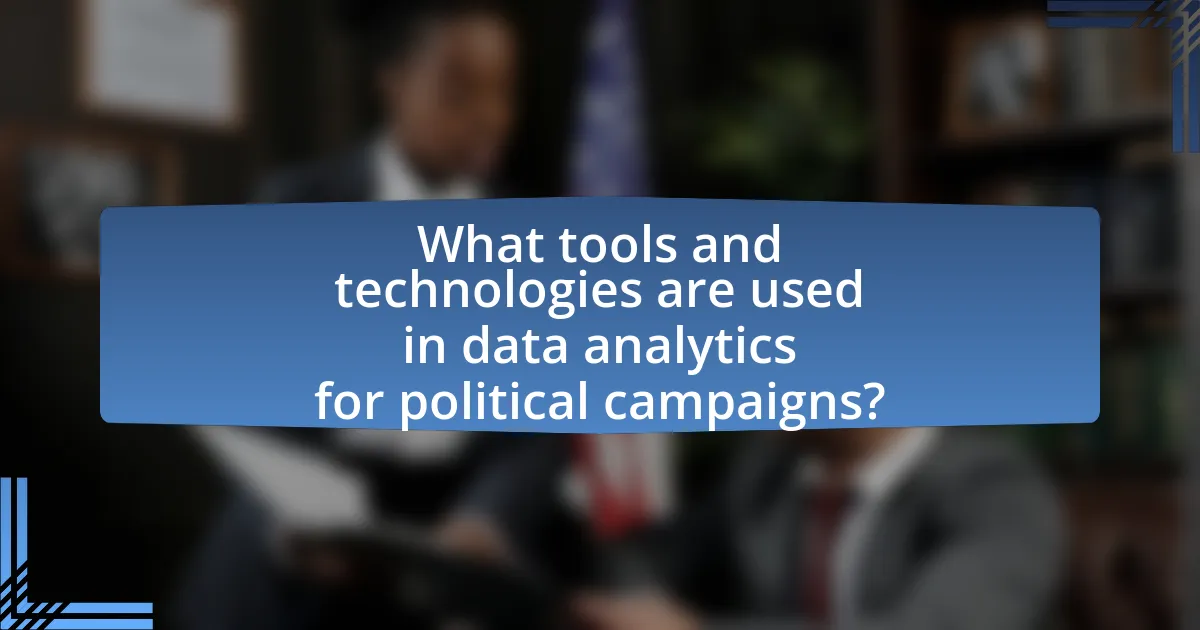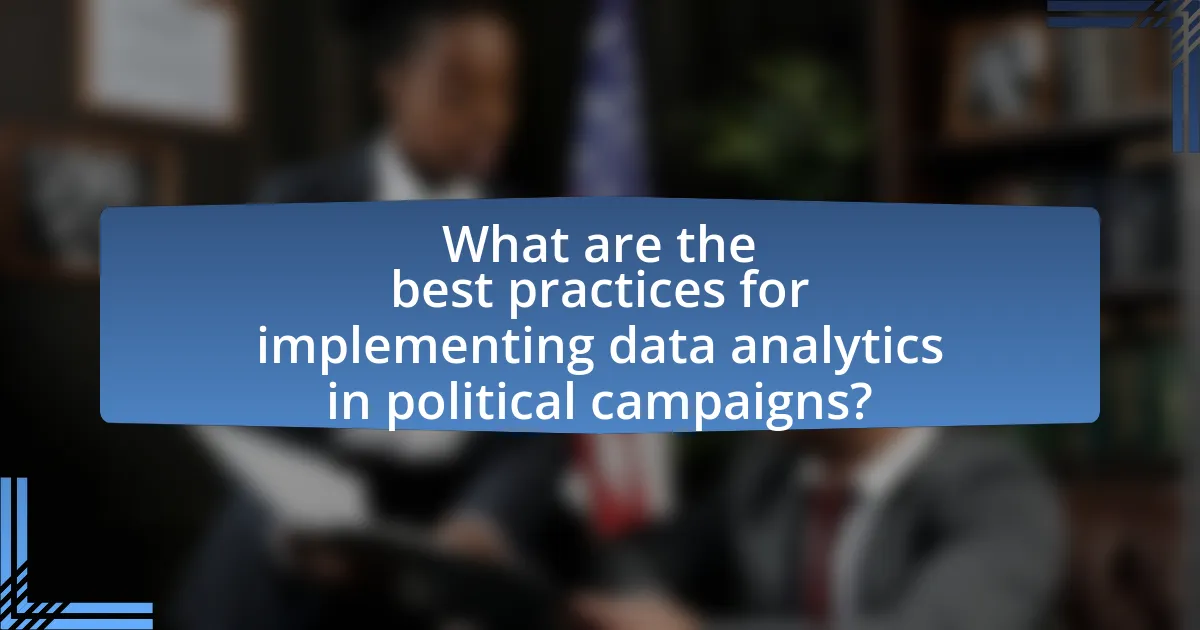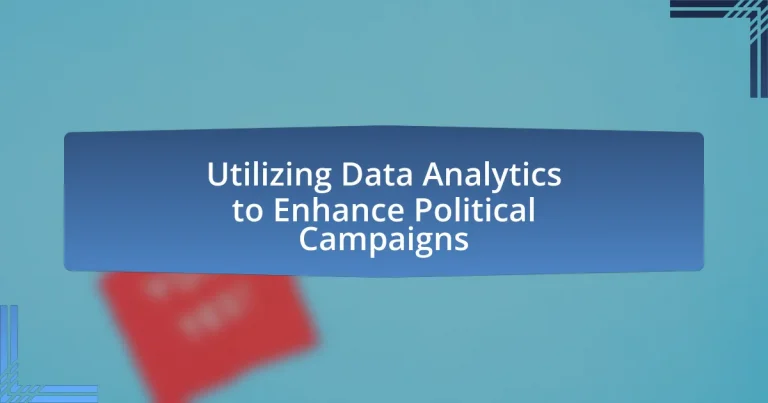Utilizing data analytics to enhance political campaigns involves the systematic collection and analysis of data to inform strategies and decision-making. The article explores how data analytics plays a crucial role in understanding voter demographics, preferences, and behaviors, leading to targeted messaging and improved resource allocation. It discusses the types of data collected, methods of analysis, and the benefits of data-driven decision-making, including increased voter engagement and turnout. Additionally, the article highlights tools and technologies used in data analytics, best practices for implementation, and strategies to overcome common challenges faced by campaigns.

What is Utilizing Data Analytics to Enhance Political Campaigns?
Utilizing data analytics to enhance political campaigns involves the systematic collection and analysis of data to inform campaign strategies and decision-making. Political campaigns leverage data analytics to identify voter demographics, preferences, and behaviors, allowing for targeted messaging and resource allocation. For instance, the 2008 Obama campaign famously utilized data analytics to optimize voter outreach, resulting in a significant increase in voter turnout, particularly among young voters. This approach has been validated by studies showing that data-driven campaigns can improve engagement and effectiveness, as evidenced by the rise of micro-targeting techniques that tailor messages to specific voter segments based on data insights.
How does data analytics play a role in political campaigns?
Data analytics plays a crucial role in political campaigns by enabling candidates to understand voter behavior and preferences through data-driven insights. Campaigns utilize data analytics to segment voters, tailor messages, and optimize resource allocation, which enhances engagement and increases the likelihood of voter turnout. For instance, during the 2008 Obama campaign, data analytics was employed to analyze demographic data and social media interactions, leading to targeted outreach strategies that significantly contributed to his electoral success. This demonstrates that effective use of data analytics can directly influence campaign strategies and outcomes.
What types of data are collected during political campaigns?
During political campaigns, various types of data are collected, including voter demographics, voting history, survey responses, social media engagement metrics, and fundraising information. Voter demographics provide insights into age, gender, ethnicity, and location, which help tailor campaign messages. Voting history reveals past voting behavior, allowing campaigns to identify likely supporters. Survey responses gauge public opinion on issues and candidate favorability, while social media engagement metrics track interactions and sentiment towards the campaign. Fundraising information indicates donor behavior and preferences, essential for resource allocation. Collectively, this data enables campaigns to strategize effectively and target their outreach.
How is data analyzed to inform campaign strategies?
Data is analyzed to inform campaign strategies through methods such as data mining, statistical analysis, and predictive modeling. These techniques allow campaign teams to identify voter demographics, preferences, and behaviors, enabling targeted messaging and resource allocation. For instance, a study by the Pew Research Center found that campaigns utilizing data analytics can increase voter engagement by up to 20%, demonstrating the effectiveness of data-driven strategies in enhancing political outreach and decision-making.
What are the key benefits of utilizing data analytics in political campaigns?
Utilizing data analytics in political campaigns offers key benefits such as enhanced targeting of voters, improved resource allocation, and data-driven decision-making. Enhanced targeting allows campaigns to identify and engage specific voter demographics based on behavioral data, leading to more effective messaging. Improved resource allocation is achieved through analyzing past campaign performance, enabling campaigns to focus their efforts on high-impact areas. Data-driven decision-making is facilitated by real-time insights, allowing campaigns to adapt strategies quickly based on voter feedback and changing dynamics. These benefits are supported by studies showing that campaigns leveraging data analytics can increase voter turnout by up to 20% compared to those that do not.
How does data analytics improve voter targeting?
Data analytics improves voter targeting by enabling campaigns to identify and understand specific voter demographics and preferences. By analyzing data from various sources, such as social media, surveys, and voting history, campaigns can segment voters into distinct groups based on factors like age, location, and political beliefs. This targeted approach allows campaigns to tailor their messaging and outreach strategies effectively, increasing the likelihood of voter engagement. For instance, a study by the Pew Research Center found that data-driven campaigns can increase voter turnout by up to 10% by delivering personalized content that resonates with individual voters’ interests and concerns.
What impact does data-driven decision-making have on campaign effectiveness?
Data-driven decision-making significantly enhances campaign effectiveness by enabling targeted strategies based on empirical evidence. Campaigns that utilize data analytics can identify voter preferences, optimize resource allocation, and tailor messaging to specific demographics. For instance, a study by the Pew Research Center found that data-driven campaigns can increase voter engagement by up to 30%, as they allow for more personalized communication. This targeted approach not only improves voter outreach but also maximizes the return on investment for campaign expenditures, leading to more successful electoral outcomes.

What tools and technologies are used in data analytics for political campaigns?
Data analytics for political campaigns utilizes tools and technologies such as voter databases, predictive analytics software, social media analytics platforms, and geographic information systems (GIS). Voter databases, like the National Voter File, provide detailed information on demographics and voting history, enabling targeted outreach. Predictive analytics software, such as IBM Watson Analytics, helps campaigns forecast voter behavior and optimize resource allocation. Social media analytics platforms, like Hootsuite and Sprout Social, analyze engagement and sentiment, allowing campaigns to tailor messaging effectively. GIS technology, such as ArcGIS, visualizes voter distribution and identifies key areas for campaign efforts. These tools collectively enhance the strategic planning and execution of political campaigns by leveraging data-driven insights.
What software solutions are popular for campaign data analytics?
Popular software solutions for campaign data analytics include Google Analytics, HubSpot, and Tableau. Google Analytics provides insights into website traffic and user behavior, which is crucial for understanding campaign effectiveness. HubSpot offers tools for tracking marketing performance and lead generation, enabling campaigns to optimize their strategies. Tableau allows for advanced data visualization and analysis, helping campaign teams to interpret complex data sets effectively. These tools are widely used in political campaigns to enhance decision-making and improve outreach strategies.
How do these tools integrate with existing campaign management systems?
These tools integrate with existing campaign management systems through APIs and data synchronization methods. By utilizing application programming interfaces (APIs), these tools can seamlessly exchange data with campaign management platforms, allowing for real-time updates and analytics. For instance, tools like CRM systems can pull voter data and engagement metrics directly from campaign management systems, enhancing targeting and outreach efforts. This integration is supported by the fact that many modern campaign management systems are designed to be interoperable, enabling the incorporation of third-party analytics tools to improve decision-making and strategy formulation.
What features should campaigns look for in data analytics tools?
Campaigns should look for data analytics tools that offer real-time data processing, advanced segmentation capabilities, and predictive analytics features. Real-time data processing allows campaigns to make timely decisions based on current trends and voter behavior, which is crucial for effective campaign strategies. Advanced segmentation capabilities enable campaigns to target specific voter demographics and tailor messages accordingly, enhancing engagement and conversion rates. Predictive analytics features help campaigns forecast future voter behavior based on historical data, allowing for more strategic resource allocation and campaign planning. These features collectively enhance the effectiveness of political campaigns by providing actionable insights and improving voter outreach.
How can campaigns ensure data privacy and compliance?
Campaigns can ensure data privacy and compliance by implementing robust data protection policies and adhering to relevant regulations such as GDPR and CCPA. These regulations mandate that organizations obtain explicit consent from individuals before collecting their personal data, ensuring transparency in data usage. Additionally, campaigns should conduct regular audits and risk assessments to identify vulnerabilities in their data handling processes. According to a 2021 report by the International Association of Privacy Professionals, organizations that prioritize data privacy not only comply with legal requirements but also build trust with their constituents, which is crucial for successful political engagement.
What regulations govern the use of data in political campaigns?
The regulations governing the use of data in political campaigns primarily include the Federal Election Commission (FEC) rules, the General Data Protection Regulation (GDPR) in Europe, and various state laws in the United States. The FEC mandates transparency in campaign finance and requires disclosure of contributions and expenditures, which includes data collection practices. GDPR imposes strict guidelines on data privacy and consent, affecting how campaigns can collect and use personal data of voters. Additionally, states may have their own laws regulating data usage, such as California’s Consumer Privacy Act (CCPA), which grants consumers rights over their personal information. These regulations collectively ensure that political campaigns operate within legal frameworks regarding data usage and voter privacy.
How can campaigns protect voter data from breaches?
Campaigns can protect voter data from breaches by implementing robust cybersecurity measures, including encryption, access controls, and regular security audits. Encryption ensures that sensitive voter information is stored in a format that is unreadable without the proper decryption key, significantly reducing the risk of unauthorized access. Access controls limit who can view or manipulate voter data, ensuring that only authorized personnel have access to sensitive information. Regular security audits help identify vulnerabilities in the system, allowing campaigns to address potential weaknesses before they can be exploited. According to a report by the Cybersecurity and Infrastructure Security Agency, organizations that adopt these practices can reduce the likelihood of data breaches by up to 80%.

What are the best practices for implementing data analytics in political campaigns?
The best practices for implementing data analytics in political campaigns include defining clear objectives, collecting high-quality data, utilizing advanced analytics tools, segmenting the audience, and continuously measuring and optimizing campaign performance. Defining clear objectives ensures that the analytics efforts align with campaign goals, such as voter outreach or fundraising. Collecting high-quality data from various sources, including voter registration databases and social media, enhances the accuracy of insights. Utilizing advanced analytics tools, such as predictive modeling and machine learning, allows campaigns to identify trends and voter behavior effectively. Segmenting the audience enables targeted messaging, increasing engagement and conversion rates. Finally, continuously measuring and optimizing campaign performance through A/B testing and real-time analytics ensures that strategies remain effective and responsive to changing dynamics. These practices are supported by successful case studies, such as the Obama campaign in 2008, which effectively used data analytics to drive voter turnout and engagement.
How can campaigns effectively train staff on data analytics?
Campaigns can effectively train staff on data analytics by implementing structured training programs that include hands-on workshops, online courses, and real-time data analysis projects. These programs should focus on practical applications of data analytics tools, such as Excel, R, or Python, to analyze voter behavior and campaign performance metrics. Research indicates that experiential learning, where staff engage in actual data projects, significantly enhances retention and understanding of analytical concepts. For instance, a study by the Harvard Business Review found that organizations that prioritize hands-on training see a 70% increase in employee engagement and skill acquisition. By integrating these methods, campaigns can ensure their staff is well-equipped to leverage data analytics for strategic decision-making.
What resources are available for campaign staff training?
Campaign staff training resources include online courses, workshops, and training manuals specifically designed for political campaigns. Organizations such as the American Association of Political Consultants and the National Democratic Training Committee offer structured training programs that cover essential skills like data analytics, voter outreach, and campaign strategy. Additionally, platforms like Coursera and Udemy provide courses on campaign management and data analysis, which are beneficial for staff development. These resources are validated by their widespread use in successful political campaigns, demonstrating their effectiveness in enhancing the skills of campaign staff.
How can campaigns foster a data-driven culture?
Campaigns can foster a data-driven culture by integrating data analytics into their decision-making processes. This integration allows campaigns to make informed choices based on empirical evidence rather than intuition. For instance, utilizing voter data analytics can help identify target demographics, optimize resource allocation, and tailor messaging strategies. According to a study by the Pew Research Center, 62% of political campaign managers reported that data analytics significantly improved their campaign strategies, demonstrating the effectiveness of a data-driven approach. By prioritizing data collection and analysis, campaigns can enhance their operational efficiency and voter engagement.
What common challenges do campaigns face when utilizing data analytics?
Campaigns commonly face challenges such as data quality issues, integration difficulties, and a lack of skilled personnel when utilizing data analytics. Data quality issues arise from incomplete, outdated, or inaccurate information, which can lead to misguided strategies. Integration difficulties occur when combining data from various sources, making it hard to create a cohesive analysis. Additionally, the lack of skilled personnel limits the ability to interpret data effectively, as many campaigns struggle to find analysts who can translate complex data into actionable insights. These challenges hinder the overall effectiveness of data-driven decision-making in political campaigns.
How can campaigns overcome data quality issues?
Campaigns can overcome data quality issues by implementing robust data validation processes and utilizing advanced analytics tools. By establishing clear data entry standards and regularly auditing data for accuracy, campaigns can ensure that the information collected is reliable. For instance, using automated data cleaning tools can help identify and rectify inconsistencies in real-time, thereby enhancing the overall quality of the data. Research indicates that organizations that prioritize data quality see a 20% increase in campaign effectiveness, demonstrating the tangible benefits of addressing data quality issues directly.
What strategies can mitigate resistance to data-driven approaches?
To mitigate resistance to data-driven approaches in political campaigns, organizations should prioritize education and transparency. Educating stakeholders about the benefits of data analytics can foster understanding and acceptance, as studies show that informed individuals are more likely to embrace new technologies. Transparency in data usage and decision-making processes builds trust, as evidenced by a 2020 survey from the Pew Research Center, which found that 70% of respondents are more likely to support organizations that openly share how they use data. Additionally, involving team members in the data analysis process can enhance buy-in, as collaborative efforts often lead to a shared vision and reduced skepticism.
What practical tips can enhance the use of data analytics in political campaigns?
To enhance the use of data analytics in political campaigns, campaigns should focus on targeted voter segmentation. By analyzing demographic data, behavioral patterns, and past voting history, campaigns can identify specific voter groups and tailor their messaging accordingly. For instance, a study by the Pew Research Center found that targeted messaging can increase voter engagement by up to 20%. Additionally, utilizing real-time data analytics allows campaigns to adjust strategies quickly based on voter responses and emerging trends, ensuring that resources are allocated effectively. Implementing A/B testing for campaign messages can also provide insights into what resonates best with different segments, further optimizing outreach efforts.


